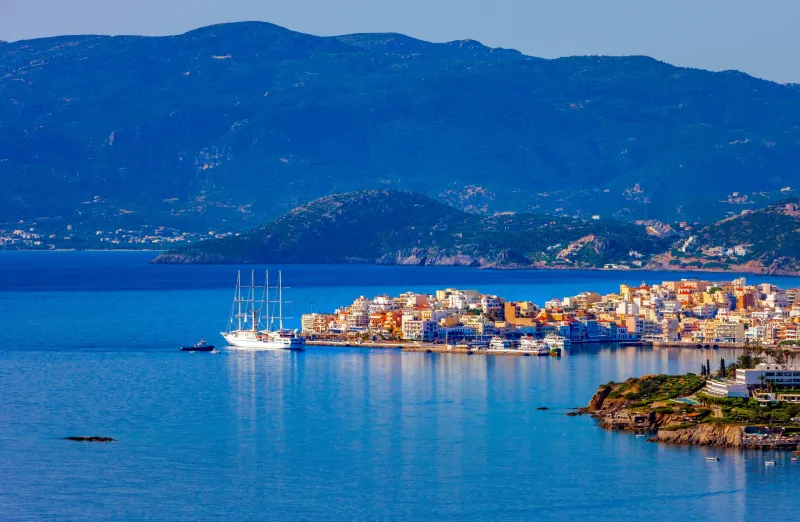
Agios Nikolaos, also known as Hagios Nikolaos or Agios Nikolaos, is a seaside town on the Greek island of Crete, east of Heraklion and west of Sitia.
The town sits partially upon the ruins of the ancient city of Lato pros Kamara (“Lato on the way to Kamara”). Lato pros Kamara was established in the late Bronze Age (1500 B.C.) as the population of Dorian Lato spread into the coastal area. Lato pros Kamara is regarded as the port of Lato and endured well into Roman times.
Modern-day Agios Nikolaos is a bustling yet understated destination that appeals to a wide range of visitors seeking a variety of holiday experiences. There are a handful of local beaches that are extremely popular, and evenings are best spent strolling the waterfront and dining at one of the town’s beautiful lakeside restaurants.
The nearby Santorini volcano is well worth a trip and relaxing in the natural hot springs of Palea Kameni Island is also recommended. Here is our selection of the best things to do in Agios Nikolaos.
Almiros Beach
Almyros Beach—the star gem of Agios Nikolaos—is located 2.5 km south of the city, near the exit of the Almiros River. Adjacent to the beach is the protected wetland of Almiros, home to several rare birds, towering eucalyptus trees, reeds, and palm trees.
This spectacular, sandy beach is quite long and very well-organized with sunbeds and a few kiosks and eateries. The water is shallow and generally calm, perfect for families with young children. There are also many water sports on offer at this beautiful Cretan beach including water skiing, banana boat rides, water scooters, and an inflatable waterpark.
The legend of Almyros beach extends to fairies that swam up here on moonlit nights and stole the voices of unsuspecting passersby. Traditionally, the women of Agios Nikolaos came to Almyros beach to do their laundry in the river and spend their entire day at the water’s edge, singing and eating under the trees.
Cretan Olive Oil Farm
The Cretan Olive Oil Farm is the present-day location of an Extra Virgin Olive Oil factory established in 1882. The original workings of the factory were carried to the site and are exhibited and used to this day. The traditional equipment used includes the old olive press, a threshing floor with four stones and an elaborate rotating mechanism, a loft with a hopper that holds 5 muzuria (lit. measures, representing a unit of some 50 kg) of olives, an old ladder, the traditional donkey yoke to pull the stones, and an ancient oil-lamp used to light the factory.
In the late 1990s, Cretan women from the local villages spent time at the farm giving lessons and instructions on how to produce authentic local cuisine. Building on that tradition, the venue nowadays offers a range of products and activities to visitors including e-guided tours with tasting, olive oil production, cooking lessons, cheese making, pottery workshops, wine tasting, Cretan festivals for groups (upon request), and a Cretan culture panorama experience (a 3-hour 3-activity package).
Lake Voulismeni
Lake Voulismeni is a small once-freshwater lake at the center of Agios Nikolaos town. It is an unexpectedly circular lake and is believed to have been created by a sinkhole when an ancient cave grew so large that it could no longer support the weight of rock above it.
It is reputed to have been the bathing place of the goddesses Artemis and Athena. Previous generations claimed that it’s bottomless and of volcanic origin, although this is not possible as there is no igneous rock in the area.
Today, it has a diameter of 137 m and is 48.8 m deep, although previous records show it to have been as deep as 64 m in 1851. The loss of depth has been attributed to soil deposits sliding into the lake, especially after the tremendous earthquake in 1856.
This deep bed of silt is believed to be the final resting place of a number of German tanks dumped by retreating WWII troops, as well as a sunken water tanker from 1975. The people of Agios Nikolaos refer to this local wonder simply as “The Lake”.
Istro Beaches
Flanked by olive groves, the valley town of Istro is located 12 km east of Agios Nikolaos and 22 km north of Ierapetra, in the Kalos Chorio district.
The most popular beaches in the area are Agios Panteleimonas and Voulisma.
Voulisma Beach (aka Golden Sand) is located in the second gulf of Istro and is one of the most beautiful beaches of Crete, often appearing on postcards of the island. It features pristine sands and exotic blue waters and a view of Brokastro Hill, where the ruins of a Minoan city are located.
Agios Panteleimonas Beach is located behind the hill and is the longest beach in the area. This beach is named after the picturesque church of Saint Panteleimon built on its sands. The beach is well equipped with umbrellas, showers, and water sports facilities. On the western stretch of the beach is the Kalos Potamos wetland. Between the trees, two WWII German artilleries can be seen.
Ammoudi Beach
Just 1 km north of Agios Nikolaos city center, Ammoudi Beach is nestled in a large and well-protected bay. It is a small sandy beach with shallow waters, making it popular with both locals and visitors. The ancient tamarisk trees and picturesque buildings bordering the beach offer a peaceful haven and plenty of Agios Nikolaos accommodations and eateries to enjoy.
There are also a variety of water sports facilities available on the beach itself. North of Ammoudi Beach, a footpath leads to the chapel of St. Nicholas, the patron saint of Greek sailors and namesake of the city of Agios Nikolaos. This extraordinary chapel was built in about the 7th century and is one of the oldest in Crete. From here, you can enjoy stunning views of the city and the bay of Mirabello.
Church of Panagia Kera
The Panagias Keras Church is a Cretan Byzantine church situated in the Dikte Mountains, 1 km from the village of Kritsa—about 11 km inland from Agios Nikolaos. This ancient church contains the best-preserved Byzantine frescoes on the island and is thus one of the most culturally and historically significant churches in Crete.
Believed to have been first established in the 13th century, the famous frescoes in Panagia Kera date back to the Paleologian Renaissance, as attested by their vivid colors. The church was home to an icon of the Virgin Mary believed to have miraculous powers. The icon was moved, returned, and lost again before finally being repainted in the church by an unknown artist in 1732. There are also frescoes of the Raising of Lazarus, the Entry into Jerusalem, the Crucifixion of Jesus, and Michael the Archangel announcing the Second Coming.
Abduction of Europa
A familiar sight adorning institutions throughout Europe, the Abduction of Europa Statue sculpture has its origins in mainland Greece and can be viewed at the Port of Agios Nikolaos in Crete.
According to the legend, Zeus saw a beautiful young princess called Europe and fancied her. As she frolicked with her friends, he approached in the form of a white bull. Her friends were entranced by the majestic creature, as was Europe. When, however, the princess climbed onto his back, Zeus stole away with her, into the sea and across to the island of Crete.
Modern anthropologists believe the myths of Zeus’ many love adventures reflect the spread of the worship of the Olympians throughout Greece: the Olympians dethroned local deities and came to be seen as supreme deities. In this reading, the abduction of Europa reflects how the Olympians came to be worshipped in Crete. An alternative, or perhaps complementary, interpretation is that it’s a reminder of how the Myceaneans conquered Crete after the fall of the Minoan civilization.
Either way, this complex tale of ‘love’ and the need to possess has been reassigned to many instances and events in European history and the image of Europe and the bull Zeus is often used to portray ideologies that are equally complex.
Have the Time of Your Life in Agios Nikolaos
The island’s rich history is mirrored in the many attractions Crete has to offer tourists. There are plenty of places to visit, from ancient ruins to natural beauty spots. Founded in 1798 during Ottoman rule, Agios Nikolaos is a popular tourist destination because of its historical sites, beaches, and nightlife.
When you rent a holiday villa in Agios Nikolaos, you get to enjoy Crete’s stunning landscapes, rich history, and unique culture. Whether you want to relax or enjoy the nightlife, there is always some fun activity to choose from, so book your accommodation, pack your sunscreen and some comfy shoes, and get exploring!



Airbnb superhost since 2014

Hellenic Association
of Travel & Tourist Agencies
